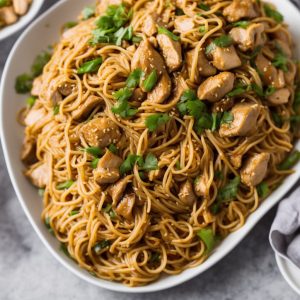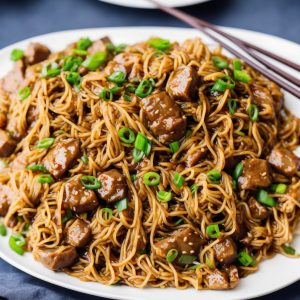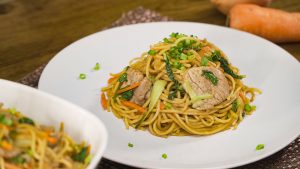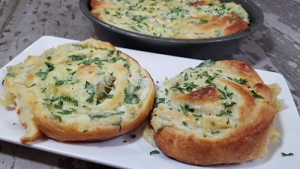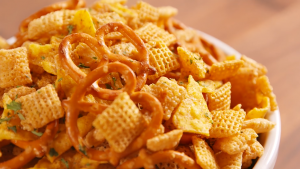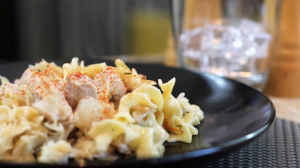Experience the vibrant flavors and textures of Asian cuisine right in your kitchen with this Vegetable Chow Mein recipe. This incredibly delicious noodle dish is packed full of fresh vegetables and seasoned with a savory blend of sauces. Whether you're a vegetarian, or simply a lover of Asian cuisine, this recipe is a must-try.
Most of these ingredients are common in Asian cooking and can be found in the international or Asian aisle of most supermarkets. If you can't find them, consider shopping at an Asian grocery store. The key ingredients you might not have at hand are the Chow Mein noodles, sweet soy sauce and oyster sauce. Chow Mein noodles are a type of Chinese egg noodle. Sweet soy sauce, also known as Kecap Manis, is a thick, sweetened aromatic soy sauce from Indonesia. Oyster sauce is a thick, dark brown liquid made from oyster extracts, which gives a savory, slightly sweet and salty flavor.
Ingredients for the Vegetable Chow Mein
Vegetable oil: Used for sautéing the vegetables to bring out the flavors.
Cabbage: Adds a crunchy texture to the dish.
Broccoli florets: Adds a hint of nutty and sweet flavor.
Celery: Provides a distinctive taste and crunch.
Carrot: Adds color and sweetness.
Garlic cloves: Brings a burst of flavor.
Sweet soy sauce: Adds a sweet and salty flavor to the dish.
Soy sauce: Enhances the overall taste.
Oyster sauce: Gives a deep umami flavor.
Water: Used to dilute the sauces.
Chow mein noodles: The main ingredient that adds a chewy texture.
Bean sprouts: Adds a nice crunch and freshness.
Sesame seeds: Used for garnishing.
One reader, Kerrin Fitzsimmons says:





This vegetable chow mein recipe is a game-changer! The combination of fresh veggies and savory sauces creates a burst of flavors. It's easy to make and perfect for a quick, healthy meal. I love how versatile it is - I can customize it with my favorite ingredients. A definite must-try!
Key Techniques for Vegetable Chow Mein
How to stir-fry vegetables: In a large pan or wok, heat the oil over medium heat and add the cabbage, broccoli, celery, and carrots. Cook for 2 to 3 minutes until the vegetables are slightly wilted.
How to add flavor to the chow mein: After the vegetables are wilted, add the garlic and cook for an additional 30 seconds. Then, add the soy sauce, sweet soy sauce, oyster sauce, and water. Bring the mixture to a boil for 1 minute to infuse the flavors into the vegetables.
How to cook the chow mein noodles: Add the chow mein noodles and bean sprouts to the pan and toss them with the vegetable and sauce mixture until well coated.
How To Make Vegetable Chow Mein
This vegetable chow mein recipe calls for fresh broccoli, carrots, celery, cabbage, and bean sprouts, but you can also substitute with your fave veggies.
Serves:
Ingredients
- 2tbspvegetable oil
- 1cupcabbage,thinly sliced
- 2cupsbroccoli florets
- 1cupcelery,thinly sliced
- 1carrot,thinly sliced
- 2garlic cloves,minced
- 2tbspsweet soy sauce,aka Kecap Manis
- 2tbspsoy sauce,low sodium
- 4tbspoyster sauce
- 1cupwater
- 12ozchow mein noodles,cooked a minute shy of the directions
- 6ozbean sprouts,optional
- sesame seeds,for garnish optional
Instructions
-
Heat a large pan or wok on medium heat with the oil add in the cabbage, broccoli, celery and carrots.
-
Cook 2 to 3 minutes until wilted, add the garlic and cook for an additional 30 seconds.
-
Add the soy sauce, sweet soy sauce, oyster sauce and water and bring to a boil for 1 minute.
-
Add in the pasta, bean sprouts and toss to coat.
Nutrition
- Calories: 446.91kcal
- Fat: 11.22g
- Saturated Fat: 1.54g
- Trans Fat: 0.11g
- Monounsaturated Fat: 6.16g
- Polyunsaturated Fat: 2.51g
- Carbohydrates: 71.75g
- Fiber: 5.17g
- Sugar: 5.21g
- Protein: 16.64g
- Cholesterol: 71.44mg
- Sodium: 1438.17mg
- Calcium: 91.90mg
- Potassium: 623.86mg
- Iron: 4.60mg
- Vitamin A: 202.14µg
- Vitamin C: 49.01mg
Essential Technique for Perfect Chow Mein Noodles
When preparing your vegetable chow mein, it's important to remember not to overcook the vegetables. You want them to retain a bit of their crunch to contrast with the soft noodles. Therefore, when sautéing the vegetables, keep the heat at medium and monitor them closely. Once they start to soften, it's time to add the garlic and sauces. This will ensure your vegetables are cooked just right, enhancing the overall texture and flavor of your dish.
Time-Saving Tips for Preparing This Recipe
Prep ahead: Chop and prepare all the vegetables and sauces in advance to streamline the cooking process.
High heat: Use a high heat setting to quickly cook the vegetables and noodles, ensuring they retain their crunch and texture.
One-pot wonder: Consider using a large pot or wok to cook the entire dish in one go, minimizing cleanup and saving time.
Quick cook noodles: Opt for quick-cook chow mein noodles to reduce the overall cooking time without compromising on taste and texture.
Batch cooking: Make a larger portion and store the leftovers for a quick and convenient meal option later in the week.
Efficient multitasking: While the vegetables are cooking, simultaneously boil the water for the noodles to expedite the overall cooking process.
Pre-portioned ingredients: Pre-measure and organize the ingredients before starting to cook for a more efficient and seamless cooking experience.
Substitute Ingredients For Vegetable Chow Mein Recipe
vegetable oil - Substitute with olive oil: Olive oil can add a rich and fruity flavor to the chow mein, and it's a healthier alternative to vegetable oil.
cabbage - Substitute with bok choy: Bok choy has a similar texture to cabbage and adds a unique flavor to the dish.
broccoli florets - Substitute with cauliflower florets: Cauliflower can provide a similar texture and absorb the flavors of the sauce well.
celery - Substitute with bell pepper: Bell peppers can add a crunchy texture and a sweet flavor to the chow mein.
carrot - Substitute with daikon radish: Daikon radish can provide a similar crunch and a slightly peppery flavor to the dish.
garlic cloves - Substitute with garlic powder: Garlic powder can be used as a substitute for fresh garlic, providing a similar flavor without the need for chopping.
sweet soy sauce - Substitute with hoisin sauce: Hoisin sauce can add a sweet and savory flavor to the chow mein.
soy sauce - Substitute with tamari: Tamari is a gluten-free alternative to soy sauce and has a similar salty flavor.
oyster sauce - Substitute with vegetarian oyster sauce: Vegetarian oyster sauce is a suitable substitute for a vegetarian or vegan version of the dish.
chow mein noodles - Substitute with rice noodles: Rice noodles can be used as a gluten-free alternative and have a similar texture to chow mein noodles.
bean sprouts - Substitute with snow peas: Snow peas can add a similar crunch and fresh flavor to the chow mein.
sesame seeds - Substitute with chopped peanuts: Chopped peanuts can add a nutty crunch to the dish and provide a different texture compared to sesame seeds.
Presenting Your Vegetable Chow Mein
- Elevate the plating: Arrange the chow mein noodles in a nest-like shape, creating a visually appealing base for the dish.
- Garnish with sesame seeds: Sprinkle toasted sesame seeds over the chow mein for added texture and a nutty flavor.
- Incorporate vibrant colors: Integrate colorful vegetables like red bell peppers or snow peas to add visual interest and freshness to the dish.
- Utilize negative space: Embrace the beauty of simplicity by allowing some areas of the plate to remain empty, drawing attention to the main components of the dish.
- Emphasize balance and symmetry: Arrange the vegetables and noodles in a balanced and harmonious manner, creating an aesthetically pleasing presentation.
Essential Tools for Making Chow Mein
- Cutting board: A flat, sturdy surface for chopping, slicing, and preparing ingredients.
- Chef's knife: A versatile and essential tool for chopping, slicing, and dicing a variety of ingredients.
- Wok: A versatile round-bottomed cooking vessel for stir-frying, steaming, and deep-frying.
- Tongs: Essential for tossing and turning ingredients in the wok or pan.
- Spatula: Used for stirring, flipping, and serving the chow mein.
- Large pan or wok: A wide, deep cooking vessel for stir-frying and tossing the chow mein ingredients.
- Cooking spoon: A long-handled spoon for stirring and mixing the chow mein ingredients.
- Pot: For boiling and cooking the chow mein noodles.
- Colander: Used for draining and rinsing the cooked chow mein noodles.
- Measuring cups and spoons: For accurately measuring the sauces and water used in the chow mein recipe.
Storing and Freezing Your Homemade Chow Mein
- Let the vegetable chow mein cool completely before storing it in an airtight container in the refrigerator. It will keep fresh for up to 3-4 days.
- To reheat, simply microwave the chow mein in a microwave-safe dish for 1-2 minutes or until heated through. You can also reheat it in a skillet over medium heat, stirring occasionally, until warmed through.
- If you want to freeze the chow mein, transfer it to a freezer-safe container or resealable plastic bag. Squeeze out as much air as possible before sealing to prevent freezer burn.
- Frozen chow mein will keep for up to 2-3 months in the freezer. To thaw, place the container in the refrigerator overnight or for several hours until completely thawed.
- When reheating frozen chow mein, it's best to do so in a skillet over medium heat. Add a splash of water or vegetable broth to help loosen up the noodles and vegetables as they reheat. Stir frequently until the chow mein is heated through and the excess liquid has evaporated.
- Note: The texture of the noodles and vegetables may change slightly after being frozen and thawed, but the flavor should still be delicious. If you find the noodles are a bit dry after reheating, try tossing them with a small amount of sesame oil or soy sauce to help moisten them up.
How To Reheat Leftover Vegetable Chow Mein
Reheat the vegetable chow mein in a large skillet or wok over medium-high heat. Add a splash of water or chicken broth to help loosen the noodles and create some steam. Stir-fry for 3-5 minutes until heated through and the noodles are separated.
For a crispy texture, spread the leftover chow mein on a baking sheet and place it under the broiler for 2-3 minutes. Keep a close eye on it to prevent burning. This method will give you a nice crispy top while keeping the noodles underneath moist and tender.
Microwave the leftover vegetable chow mein in a microwave-safe dish. Cover the dish with a damp paper towel to prevent the noodles from drying out. Heat on high for 1-2 minutes, stirring halfway through, until heated through.
If you have a steamer basket, you can place the leftover chow mein in it and steam for 3-5 minutes until heated through. This method will help retain the moisture in the noodles and vegetables without making them soggy.
For a quick and easy lunch, pack the leftover vegetable chow mein in a microwave-safe container and reheat it at work. Add a splash of water or soy sauce to help loosen the noodles and prevent them from drying out. Microwave on high for 1-2 minutes, stirring halfway through, until heated through.
Interesting Fact About Vegetable Chow Mein
Chow mein noodles are a staple in Chinese cuisine and are often stir-fried with a variety of vegetables and sauces to create a delicious and satisfying dish.
Is Making Vegetable Chow Mein at Home Cost-Effective?
This vegetable chow mein recipe is quite cost-effective for a household. With affordable ingredients like cabbage, broccoli, and carrots, it offers a budget-friendly option for a family meal. The use of simple pantry staples like soy sauce and oyster sauce adds flavor without breaking the bank. The approximate cost for a household of 4 people is around $15-20, making it an economical choice. As a culinary chef, I would rate this recipe an 8 for its affordability and delicious flavors.
Is Vegetable Chow Mein Healthy?
The vegetable chow mein recipe is a relatively healthy dish, packed with nutrient-rich vegetables like cabbage, broccoli, celery, carrots, and bean sprouts. These vegetables provide essential vitamins, minerals, and dietary fiber, which are crucial for maintaining good health. The use of garlic adds flavor and has potential health benefits, such as boosting the immune system and reducing inflammation.
However, there are a few aspects of this recipe that could be improved to make it even healthier:
- The recipe calls for a significant amount of soy sauce and oyster sauce, which can be high in sodium. Consuming too much sodium can lead to high blood pressure and other health issues.
- The type of noodles used in the recipe is not specified. If the chow mein noodles are made from refined flour, they may lack fiber and other essential nutrients.
To make this recipe healthier, consider the following suggestions:
- Reduce the amount of soy sauce and oyster sauce used in the recipe, or opt for low-sodium versions of these condiments. You can also replace some of the soy sauce with a squeeze of fresh lemon juice to add brightness and balance the flavors.
- Choose whole wheat or buckwheat noodles instead of refined flour noodles to increase the fiber content and overall nutritional value of the dish.
- Add more vegetables to the recipe, such as bell peppers, mushrooms, or bok choy, to increase the variety of nutrients and flavors in the dish.
- Use a lean protein source, such as tofu, shrimp, or chicken breast, to make the dish more balanced and satisfying.
- Instead of using vegetable oil, consider using healthier cooking oils like olive oil or coconut oil, which contain beneficial fatty acids.
Editor's Opinion on This Vegetable Chow Mein
This vegetable chow mein recipe is a delightful combination of fresh vegetables and savory flavors. The use of sweet soy sauce and oyster sauce adds depth to the dish, while the addition of bean sprouts provides a satisfying crunch. The cooking instructions are clear and easy to follow, making it accessible for home cooks of all skill levels. Overall, this recipe promises a delicious and satisfying chow mein that is sure to please the palate.
Enhance Your Vegetable Chow Mein Recipe with These Unique Side Dishes:
Similar Recipes to Try If You Love Chow Mein
Perfect Appetizers and Desserts to Complement This Recipe
Why trust this Vegetable Chow Mein Recipe:
This recipe offers a delightful combination of fresh vegetables and savory sauces, creating a harmonious blend of flavors and textures. The use of oyster sauce and soy sauce adds depth and richness to the dish, while the inclusion of chow mein noodles provides a satisfying base. The incorporation of bean sprouts introduces a delightful crunch, and the finishing touch of sesame seeds adds a nutty aroma. With a balance of vibrant colors and wholesome ingredients, this recipe promises a delightful and satisfying culinary experience.
Was this page helpful?
Have your own special recipe to share? Submit Your Recipe Today!




